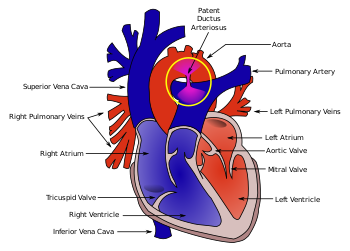Patent ductus arteriosus
| Patent ductus arteriosus | |
|---|---|
 |
|
| Heart cross-section with PDA | |
| Classification and external resources | |
| Specialty | Cardiac surgery |
| ICD-10 | Q25.0 |
| ICD-9-CM | 747.0 |
| OMIM | 607411 |
| DiseasesDB | 9706 |
| MedlinePlus | 001560 |
| eMedicine | emerg/358 |
| Patient UK | Patent ductus arteriosus |
| MeSH | C14.240.400.340 |
Patent ductus arteriosus (PDA) is a condition wherein the ductus arteriosus fails to close after birth.
Early symptoms are uncommon, but in the first year of life include increased 'work of breathing' and poor weight gain. An uncorrected PDA may lead to congestive heart failure with increasing age.
The ductus arteriosus is a fetal blood vessel that closes soon after birth. In a PDA, the vessel does not close and remains "patent" (open), resulting in irregular transmission of blood between the aorta and the pulmonary artery. PDA is common in newborns with persistent respiratory problems such as hypoxia, and has a high occurrence in premature newborns. Premature newborns are more likely to be hypoxic and have PDA due to underdevelopment of the heart and lungs.
A PDA allows a portion of the oxygenated blood from the left heart to flow back to the lungs by flowing from the aorta (which has higher pressure) to the pulmonary artery. If this shunt is substantial, the neonate becomes short of breath: the additional fluid returning to the lungs increases lung pressure, which in turn increases the energy required to inflate the lungs. This uses more calories than normal and often interferes with feeding in infancy. This condition, as a constellation of findings, is called congestive heart failure.
In some congenital heart defects (such as in transposition of the great vessels) a PDA may need to remain open, as it is the only way that oxygenated blood can mix with deoxygenated blood. In these cases, prostaglandins are used to keep the DA open until surgical correction of the heart defect is completed.
Common symptoms include:
Patients typically present in good health, with normal respirations and heart rate. If the PDA is moderate or large, widened pulse pressure and bounding peripheral pulses are frequently present, reflecting increased left ventricular stroke volume and diastolic run-off of blood into the (initially lower-resistance) pulmonary vascular bed. Prominent suprasternal and carotid pulsations may be noted secondary to increased left ventricular stroke volume.
A PDA is sometimes idiopathic. Known risk factors include:
...
Wikipedia
